Today we have another article by Ronaldo Olive, reprinted with his permission. This was originally published in Jane’s Defense Weekly in 1984, when the LAPA FA-03 was still more or less in prototype phase – bullpup rifles have become more widely accepted since then. Unfortunately for LAPA, the Modelo 03 was not accepted for military use, and no foreign orders were received – only this single prototype was ever built. So without further ado, read on about this Brazilian combat rifle with some interesting features. Thanks, Ronaldo!
Brazilian 5.56mm LAPA Assault Rifle Reaches Official Testing Phase
by Ronaldo Olive
The appearance of yet another 5.56mm assault rifle on the military scene may not attract much attention, unless it has the now fashionable bullpup configuration, which gives it an increased chance of receiving more than just a casual glance. And if this rifle incorporates novel and mainly useful features, then it deserves a thorough examination. This is the case of the LAPA FA Modelo 03, a newcomer to the small-caliber rifle arena, which is about to start official certification testing at Campo de Provas de Marambaia (Marambaia Proving Grounds), a branch of Brazil’s CTEx – Centro Tecnologico do Exercito (Army Technical Center). Janes Defense Weekly was recently given the chance to fire this new gun and to assess its general characteristics.
The FA (Fuzil Automatico, or Automatic Rifle) Modelo 03 was designed by LAPA – Laboratorio de Projectos de Armamento Automatico (Automatic Armament Design Laboratory), a Rio de Janeiro-based R&D concern. Initial work started at the end of 1978. After about a year, a technical feasibility prototype was completed, and its most promising characteristics led to additional prototypes to refine the design. Unavoidable snags were gradually removed and the Brazilian weapon has evolved into a working, reliable reality. Following certification, it is to enter production to meet local and foreign demand, but the company would not be specific about dates. Nor would is comment on reported approaches by foreign countries interested in licensed production agreements, but considering the hard competition in the arms business, its reticence in making some details public is understandable.
Description
The rifle’s bullpup arrangement is the result of wishing to make it as compact as possible without shortening the barrel to a point where ballistic efficiency is degraded. So, the trigger is mover forward and the firing mechanism, together with the magazine, is fitted in the hollow of the buttstock.
The body of the LAPA FA Modelo 03 is built largely of high-impact plastic, has particularly elegant contours and is pleasant to handle and carry. A well-designed straight-line configuration has in fact resulted in the rifle being able to stand balanced on its buttplate! This has also dictated the raised sights configuration: the rear sight, a two-position (200m and 400m) flip aperture, is housed within the AR-10 style carrying handle, while the front sight is a protected post on top of a stury raised metal frame at the muzzle. Radius is a generous (for the bullpup configuration) 374mm (14.7 inches). The cocking handle, which remains stationary when the gun is fired, is within the carrying handle, and the top end runs along a slot on the underside of the handle, giving it more rigidity.
Ammunition
At present, the gun is chambered for the 5.56x45mm M193 ball-type cartridge, the 490mm (19.3 inch) barrel having six-groove rifling with a pitch of one turn in 305mm (1:12 inch). Production examples, as expected, will also be barreled for the newer SS109 NATO round. A flash hider is fitted to the muzzle, and a bayonet attachment is provided. Feed is from 20- or 30-round M16-type metal box magazines in the prototype, but production gun are likely to use curved 20-, 30-, or 40-round plastic magazines. The magazine is inserted upwards into its guide inside the stock, and the catch at the rear is pressed forward to release the magazine. The ejection port, which can be set easily for right- or left-handed shooters, is fitted with a spring loaded cover that snaps open as the weapon is cocked or fired.
Firing Mechanism
The real innovations are those found in the firing mechanism. In place of the more conventional applied safety arrangements, the FA Modelo 03 has a double-action setting for the hammer, keeping it ready for immediate use, and at the same time protected from accidental firing. A single lever, on the left side of the stock between the magazine housing and the buttplate, is set for one of the three firing modes (“30” for full auto; “3” for controlled 3-round burst; “1” for semiautomatic fire) and the two action modes (“SA” for single action and “DA” for double action).
After or before cocking and feeding the weapons, which is done by pulling the cocking handle about 110mm (4.3 inches) backwards and releasing it, the shooter sets the fire-selector lever at one of the three fire positions. If fired immediately, the rifle will be set for single action, thus featuring a shorter and lighter trigger pull. After firing some rounds, or if no immediate use is anticipated, the lever can be turned to the “DA” mark and returned to one of the three fire positions. This will drop the hammer, allowing the gun to be carried in complete safety with a chambered round and ready for action: all that is needed is to pull the trigger (which will have a longer and heavier pull) to fire the rifle. If more accuracy is required for the first shot, the firer can move the lever to the “SA” marking and back to the chosen fire position, which will make the weapon fire the first round single-action. Operation is by gas, tapped from a port located about 160mm (6.3 inches) from the muzzle, which actuates an orthodox piston/rod assembly. Breech locking is achieved by the lugs of the rotating bolt.
Disassembly
Field stripping for routine cleaning is relatively simple requiring no tools. After removing the magazine and checking that the gun is unloaded, the buttplate pin is removed sideways to the right, which allows the buttplate together with the return spring and its guide to be pulled away and out of the stock. The takedown pin, aft of the pistol grip, is then removed from the weapon sideways to the right, separating the body into two halves. The lower half, which includes the magazine housing, pistol grip and the forward handguard, houses the firing mechanism, which becomes fully exposed for normal cleaning, no additional disassembly of this group being necessary. With the cocking handle pulled to the rear position, the top plastic cover can be removed, exposing the barrel/bolt assembly. The cap of the metal tubular receiver is unscrewed, and this allows the bolt and bolt carrier group to slide out. The gas rod and piston may then be removed. A reversed procedure is used to reassemble the weapon.
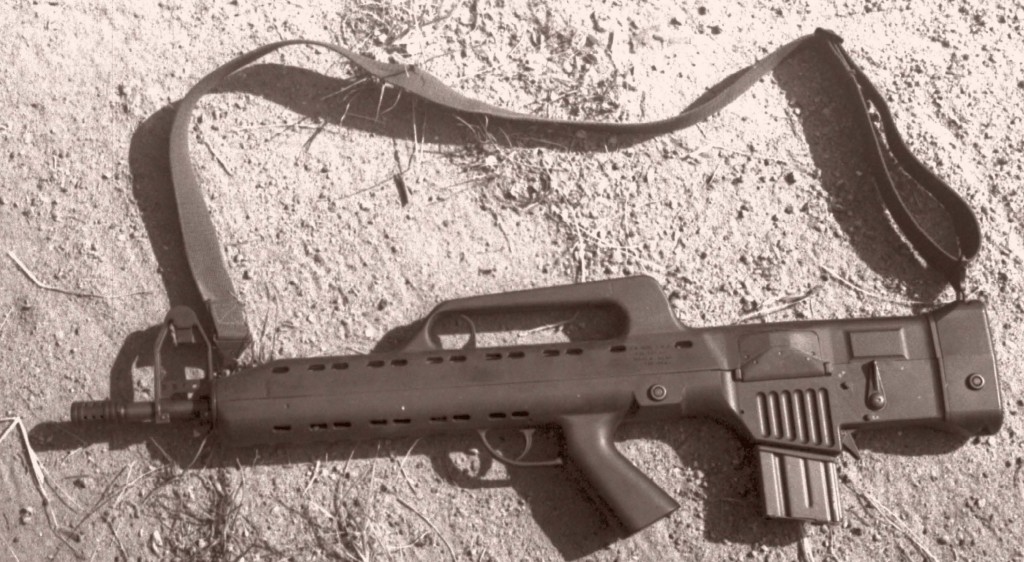
Shooting Impressions
Bullpup rifles are not easily found, especially in Brazil, so this was a first hands-on experience. Despite psychological preparation, the first impression is one of a “Star Wars” type weapon, even though the lines of the FA Modelo 03 are conservative if compared with, say, the Steyr AUG. After handling for a few minutes, however, and getting accustomed to the unusual magazine location, its compactness can be appreciated: only 735mm (28.9 inches) long, and with very smooth surfaces, in is “pleasant” to handle and carry, which is especially important for long marches, when the rifle is carried by the sling on one’s body. The forward sling attachment turns freely around the barrel, and coupled to a two-position (on/under the stock) rear attachment, it allows the rifle to be carried in various positions.
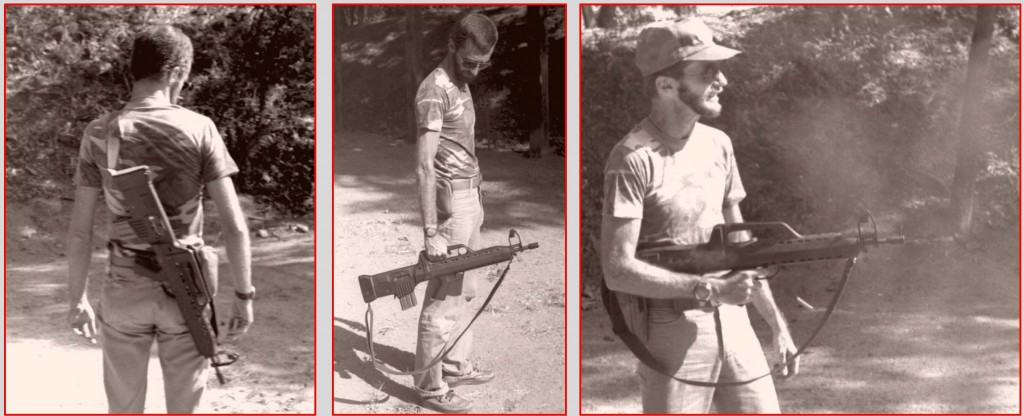
Firing from the Shoulder
Without its magazine, the prototype LAPA assault rifle weighs 3.2kg (7.0 pounds), though production weapons are expected to weigh 2.8kg (6.2 pounds). For aimed shoulder fire the sights are at a comfortable position for the eye. The spring-loaded rear sight flips to either 200m or 400m position easily, at the same time being rigid enough to not be displaced by accident. It is adjustable for windage, while the protected post front sight can be adjusted for elevation. The rear sight aperture is a little too small for quick target acquisition, but this is to be rectified in production weapons says LAPA.

The position of the cocking handle, on top of the gun, makes it ambidextrous, but because it has to be pulled with one or two fingers, the pull seems heavier when compared to a handle that can be held with thumb support. This is more than compensated for, however, by the handle remaining out of the way at all times.
The testing range was physically limited to about 50m, so long-distance accuracy was out of the question. Fired from the shoulder, the rifle is comfortable and provides a good rest for the firer’s cheek on the stock. Although the breech is closer to the ear than in conventional rifles there is no noticeable increase in noise level, though instrumented measurements may prove the contrary. The rifle’s straight-line configuration, with the barrel axis extending directly to the shoulder together with the very low recoil inherent to the 5.56mm ammunition, keeps the FA Modelo 03 rock-steady in semiautomatic fire. In this mode, fired standing, kneeling and prone, the gun handled well.
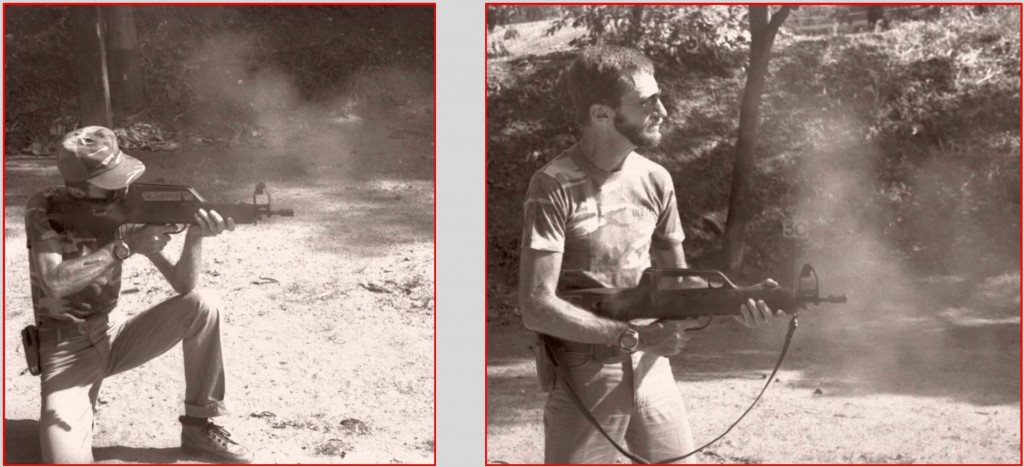
Controlled 3-round bursts were fired both from the shoulder and hip, the weapons always remaining very stable. The trigger has to be kept pulled for the duration of the burst. In this setting, if only one or two rounds are fired, the mechanism will reset automatically to be ready to fire three more times when the trigger is pulled again.
Automatic Fire
A great deal of automatic fire (at about 700 rounds/minute) was carried out, with the weapon held at hip height, assault style. Again, controllability was excellent, and the extreme compactness of the design, making the rifle only about 60mm (2.4 inches) longer than most stocked submachine guns, would be a definite bonus in close-in combat. Instinctive fire in multiple-target engagements, for instance, is greatly facilitated by the pistol grip being located almost halfway down the gun’s length, enabling quicker movements of the barrel at different targets. Single-handed shooting, with and without sling support, shows its remarkable balance and with a slight pressure between arm and body the rifle is kept steady even in full auto.
In photographs the ejection port may appear too close to the arm for comfort, however, in practice spent cartridges eject well away above and forward, not even the warmth of gases being felt by an unprotected arm, thus safety is in no way jeopardized.
Technical Specs
Caliber: 5.56mm
Cartridge: M193 55gr NATO 5.56x45mm
Rifling: Six groove, 1:12″ twist
Overall weight (empty): 3.2kg (7.0 pounds)
Overall length: 735mm (28.9 inches)
Barrel length: 490mm (19.3 inches)
Sights: Rear dual flip aperture (200m & 400m), front post
Sight radius: 374mm (14.7 inches)
Magazine capacity: 20- or 30-round (STANAG magazines)
Rate of fire: 700 rounds/minute

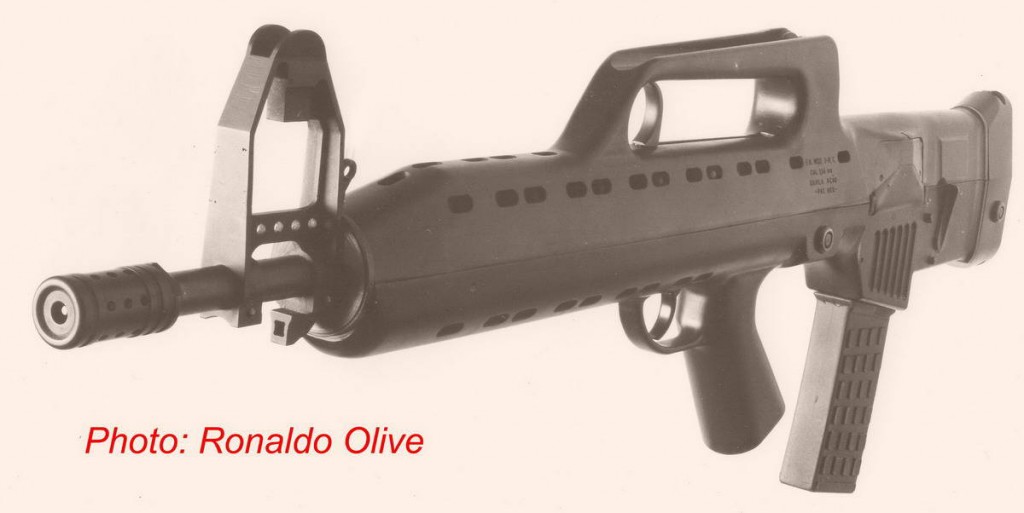
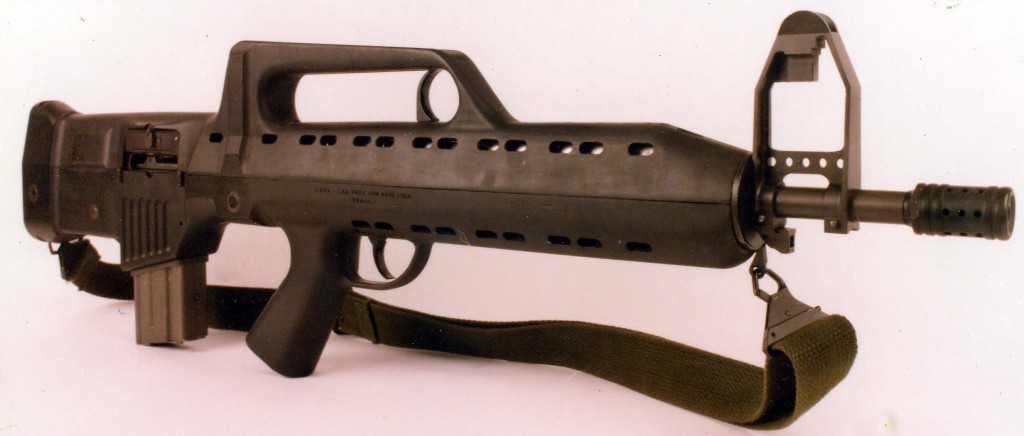

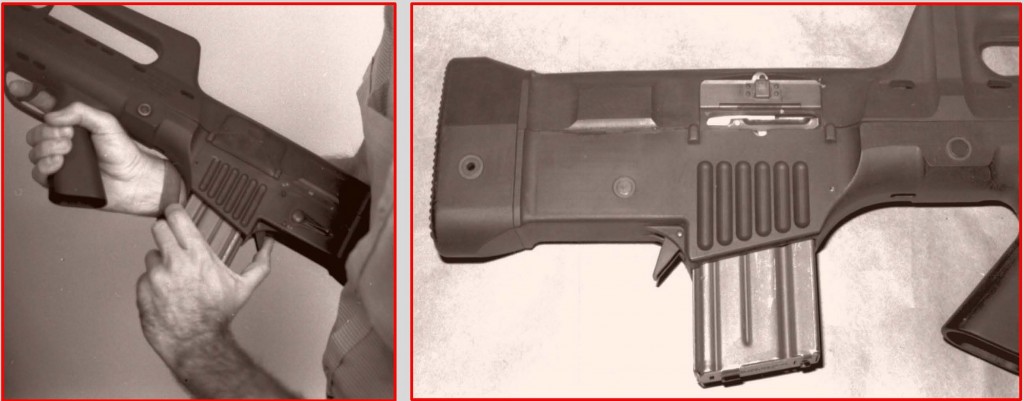
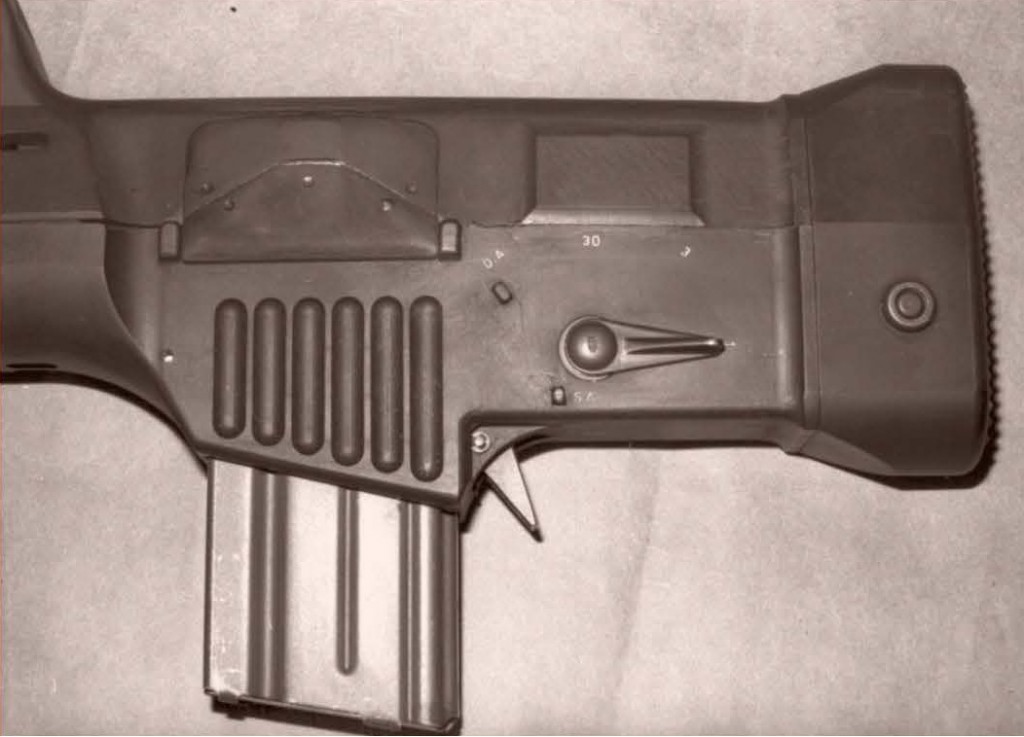
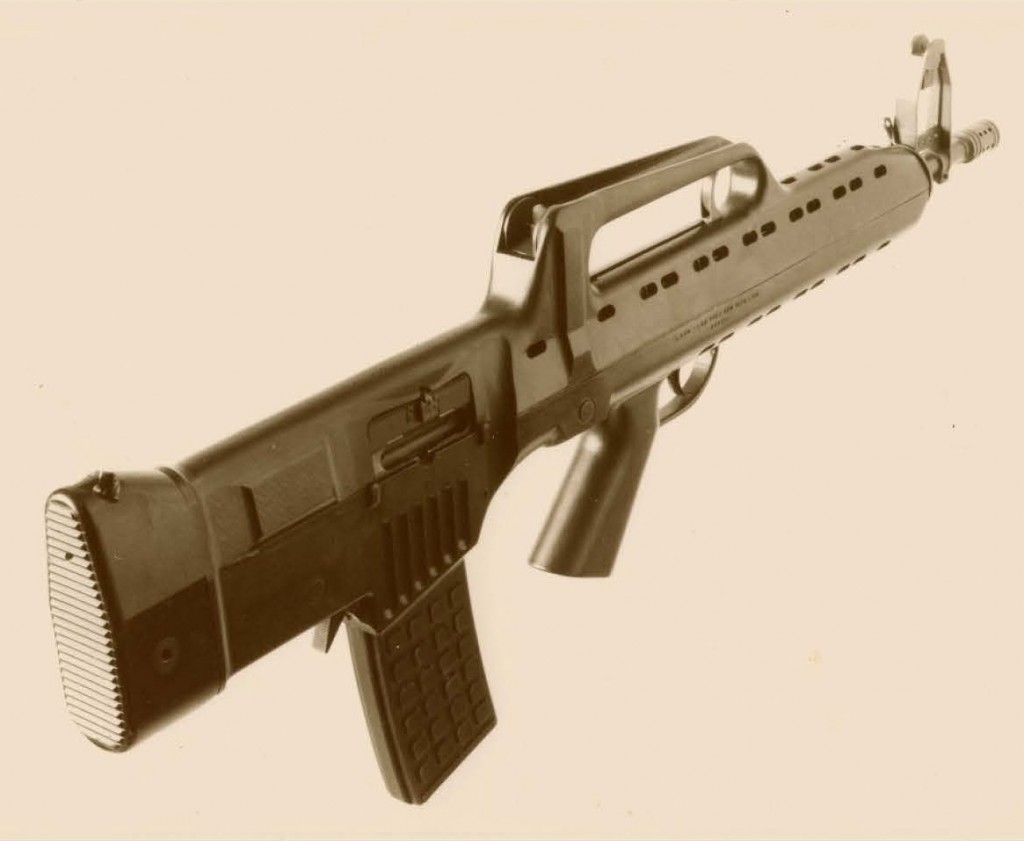
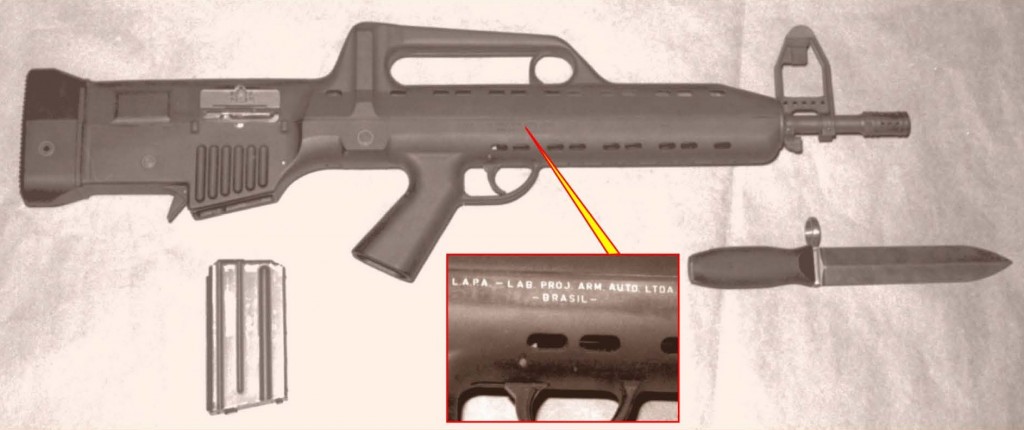

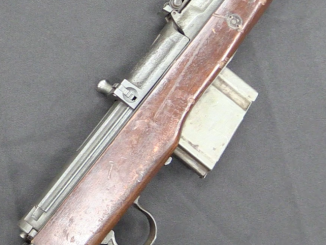
OMG! I remember the article – this was the first issue of Jane’s that I ever laid my paws on. I still may have it stashed somewhere, under the sea of papers…
Silly nitpicking, but you need to change your first sentence to “5.56mm” instead of “.556mm”. Calibers aren’t trending that small yet.
This really is a “forgotten weapon”. I remember seeing picture of it first time at least 25 years ago, if not longer than that. That time I was involved with designing polymer gun parts so I naturally became intrigued by the fact that its body extended all the way over the gas tap. If I was to face the task, I’d probably made the front out of sheet metal or at least with metal lining. But plastics changed and improved since.
When I see today these detail pictures I start to appreciate couple of things, not visible from available materials then. One is the fairly slim profile of receiver, it looks quite good. The other is texture of surface; yes it looks like ubiquitous glass-filled Zytel.
Good work and good reminder!
Want a REALLY “forgotten weapon”? Try the U.S. “Armored Combat Earthmover” (ACE)
The U.S. Army Armor and Engineer Board was working on it when I was assigned there in the ’80s. The design was horrendously complicated (and I believe over-budget) and was in trouble at the time. Around the USAARENBD offices were concrete pads with examples of a number of past projects, including the MBT-70 and… the ACE. I just happened to look at the info plate for the ACE display, and I’m pretty sure that it said something like “1962” on it. During the first Gulf War, I was astonished to see the ACE actually FIELDED
Like Christopher Lee in Hammer Dracula movies, or “Michael Myers” in the “Friday the Thirteenth” series, the ACE just kept getting killed off, only to reappear in the nightmares of project officers on the Engineer side of the Board, again and again.
Some projects you just can’t kill…
The MBT-70 — Now there was an armored weapons system that had great potential but was too far ahead of its time, and which was subject to too many add-ons ( which contributed to its high cost, mechanical complication and eventual demise ). Still, a lot of what was learned with the MBT-70 project was later successfully incorporated into the M-1 Abrams MBT.
The MBT-70 and the Cheyenne attack helicopter were failed contemporaries which both pointed the way to highly successful beneficiaries of “lessons learned”.
There were a number of “also rans” in my brief military service, including the M202 incendiary launcher and the “Firing Port Weapon”.
Oh yes, good thing you mentioned the Cheyenne attack helicopter. A lot of the design concepts were incorporated in the later AH-64 Apache, if I remember correctly. Come to think of it, the Cheyenne and the Apache have a certain familial resemblance, as do the MBT-70 and M-1, doubtless a by-product of those “lessons learned”. Thanks for sharing your experiences, Chris!
Chris, thanks for the great information based on your personal experiences and observations! You probably already know about what I am going to write about next, so please bear with me as this is for the purposes of sharing with other FW members.
When I was still in the military, the M202 quadruple-tube incendiary rocket launcher ( based on the 66mm M72 LAW ) was the subject of much anticipation since it was supposed to provide anti-fortification and anti-personnel capability per the World War Two era flamethrowers, albeit at much greater ranges and with a more devastating immediate effect on the target as well as the advantages of interchangeable warheads ( this last feature was part of the prototype XM191 whereby the M72 HEAT round could be used in the launcher, but apparently production M202’s deleted this capability ). As I understand it, the improved M202A1 version was actually introduced into field service with the infantry but subsequently put into storage in the mid- to late 1980’s against the day it might be really needed due to its bulk, which did not endear it to the troops insofar as portability was concerned. However, it was still retained in the official TO & E and was supposed to have been listed as one of the infantry weapons available to U.S. troops in Afghanistan.
The M231 Firing Port Weapon ( FPW ) is restricted to the usage for which it was first developed — as a short-barreled ( 15.6″ ) specialized version of the M-16 rifle firing only in full-automatic mode at 1100-1200 rds. / min. and designed specifically to be used in conjunction with the firing ports in the M2 / M3 Bradley IFV. In an emergency, it can be dismounted and used as a hand-held defensive weapon by the vehicle’s crew, although this is regarded as a last-ditch measure since the weapon does not have a buttstock.
I recall (perhaps incorrectly)the M202 being withdrawn because of safety issues, in particular explosions in the launch tube(s).
I was never in a Bradley equipped unit, but if I recall correctly, the FPW was withdrawn after the advent of applique armor mooted its existence. No firing ports = no FPW.
I’d have one question to Ronaldo: if this did not become military issue weapon, and I’d say it was pretty advanced for its time, what’s going on at Imbel’s turf? They seem to adopted thinking “more plastic, the better”. Are they advancing towards production with their last creation?
Overengineered five position “gearshift lever” and no safety in reach of right hand. No wonders the rifle didnt make it.
I agree on that point. However, taking the DA/SA design to the form of the rifle is not necessarily a bad idea. I’m sure it would have been ironed out had it been viable for longer than just a few hundred prototype models. Maybe a separate lever or something like that. Though, militaries in general have long been wary of letting their soldiers actually learn how to use the damn rifle and be proficient with it, rather than rely so much on a mechanical blocking method. Honestly, I don’t blame them, but it all comes back to a training issue.
My sense is that this rifle was destined more to security rather than to military service in first place. The feature with DA trigger reminds me of Spectre SMG; that was/ is an excellent (undercover) police gun.
As for safety, they could have added one to grip area to directly block the trigger. It probably was not deemed as priority at the time of conception.
As always, knowledgeable and thoughtful comments from the FW crew. This rifle appears to have fallen victim to the ever-present and prevalent bugbear that has claimed so many other promising designs — excellent innovation and quality stymied by bad market timing and compounded by the lack of resources to adequately publicize the weapon’s virtues vis-a-vis the established, more conventional competition. In that sense, the battle for hearts and minds ( and, eventually, wallets ) is not relegated to the arena of broad-spectrum international politics as we know it. One can think of many, many areas of human endeavour that fit this mold.
To set the record straigh:
no matter what you may have read in the Internet, ONLY THE ILLUSTRATED FIRING PROTOTYPE WAS EVER BUILT!
Ronaldo, this is a very good article that you have written — factual, objective and driven by practical considerations, yet interesting and historically fascinating. How many people can honestly say that they have had the privilege and opportunity to handle and fire a singular prototype firearm, then critique it from a user’s standpoint?
Thank you so much for letting FW post this for our edification. And many thanks also to Ian for making this happen.
Don’t know enough to comment on practicalities, but I have to say that’s probably the prettiest bull-pup design I’ve seen
No pictures of the internals, any patents, whatsoever? That’s such an intriguing rifle.
A prototype may have sophisticated features, but
if produced, usable ones will be selected by field
experiments and by time. This sample would be much
promising.
Per my June 7, 2013 / 4:27 p.m. post, does anyone know the specific reasons as to why the rifle did not make it beyond the prototype stage? By the way, it does have have graceful lines as Nick has pointed out, and reminds me to some extent of the Singapore Technologies SAR-21 bullpup rifle. Markus’ inquiry about the internal working mechanism and patents also bears further investigation.
LAPA bullpup rifle: the final story
A long time ago, Nelmo Suzano, the rifle’s designer, told me that shortly after it had been sent to Brazilian Army’s Marambaia Proving Ground in Rio de Janeiro for the official certification program that would clear it for series production (it was not, in fact, an Army evaluation for possible use) he received reports that three case extraction problems had occurred in about 500 rounds fired. Since he and several other people, including myself, had already fired thousands of rounds through the gun with virtually no problems, he became justly surprised and headed to the test center to get the rifle back and the remaining 5,500 or so rounds left of the 6,000 total of CBC ammunition that had been acquired for the tests. A detailed examination of the gun showed no problems with both internals and externals, so Nelmo turned his attention to the ammo.
The cartridge cases involved in the incidents presented what he called “overpressure bulges”. After examining an measuring each of the unfired rounds, he found out that 64% of them presented size or shape discrepancies that would lead to unacceptable headspace variations when chambered and fired. More so, some rounds were found with the primer mounted backwards (!) and quite a few had the bullet out of alignment with the case. Nelmo then took the defective rounds to the CBC factory and showed them to a top company executive, who could give no satisfactory explanations other than saying the “heads would roll”… In the event, the rifle was not returned to the Marambaia Testing Ground, other associates of the LAPA company gave up their financial participation in the program and Nelmo was left alone. At that time, he had received a request from the Malaysian military who wanted that eight guns be sent immediately for an evaluation program that would lead to the local production of the Brazilian bullpup rifle. He could not have the guns completed at that short notice, so the whole thing did not proceed further. It should be recalled that, later, the Steyr AUG was adopted by Malaysia and produced there under license…
I remember ammunition recalls from CBC in the ’90s. Friends and I were very active collectors and shooters in the heyday of imported surplus rifles. We started out with Prvi Partizan, and when the Balkan Wars started, switched over to CBC which replaced Hanson as the source for affordable 6.5x55mm, .30-06, 7.62x54mmR and 7.92x57mm.
It’s completely plausible that defective ammunition from CBC could have been a problem.
Thanks for the clarification. I am very sorry to hear of Nelmo Suzano’s problems — just plain bad luck and unfortunate timing combined. What a pity, too, for the rifle appears to be such a promising design. It was also surprising to read about CBC’s QA / QC issues, for they normally have an excellent reputation for producing high-quality Mil-Spec ammunition.
For the most part, CBC was an acceptable substitute for Prvi Partizan when that became unavailable, with the added benefit of even more cartridges being available, including if I recall, 7.65x53mm Mauser. There were however QA/QC issues, involving excessive powder charges as I recall. The great benefit of course to both Prvi Partizan and CBC was that the cases were Boxer primed. A friend and I were reloading both for years afterward.
You are probably correct about CBC’s QA/QC issues during that unfortunate period during the 1990’s. Presumably, they have long since addressed the problem as general performance of their ammunition has been very good for many years up to the present time. I use a lot of PPU ( Prvi Partisan ) and CBC ( Magtech ) ammunition in various calibers, and have always had excellent and consistent results with both brands. I suppose that is all part of constant product improvement on the part of any conscientious and quality-oriented manufacturer.
Interesting note about CBC and their ammo. I must add that I experienced some (many…) problems with a batch of .32 pistol ammo manufactured somewhere in the late 1970s/early 1980s. The inconsistencies were of such order that my relative, who actually owned the batch, decided to salvage the brass (and the bullets, I think).
Recent CBC ammunition is up to the task. As for Prvi Partizan, their products are excellent; they also cater for the needs of those who fancy ‘exotic’ or harder to find calibers. They still manufacture 7.5×54 French and .303 British to full military specifications.
A fascinating rifle that I’d never even heard of before. Truly a perfect example of what this site is all about.
I remember these in tests back around 1980. They were not as good an the AUG and slightly better than the FAMAS because of the sights. The magazines were rugged and the weapon stripped easily. But with use they started to feel lose like they were self destructing. They did shoot very well but our XM177E2s (aka M4) were much better. These were meant for a philosophy of war that depended on APCs and Helicopters where space was at a premium and ammunition load was still being figured out. Early 7.5 and 7.62 NATO weapons were heavy and big. “Modern “war was against AK armed opponents and was fought at 300 meters, The AK is not at its best at 300m the 5.56 is and it is easy to carry more ammo. Our goal was to find the best weapon of the day. This one could have been a contender if it had been better designed.
For the people wondering why this wasnt adopted, as a brazilian, i can tell somethings: during the 80’s we had several budget and political problems, so changing the rifle wasnt an option. After 1985 we had a government shift and the military governmnet who developed this rifle was out, the new gpovernment didnt care about those things, by the way, in 1964 the military government adopted the FAL and this rifle kept being our standart rifle until around 2014 when the started to implement the IA2 rifle, which is a miracle considering the terrible government, elected with poor people manipulation, that doesnt care about defense, no wonder why many illegal guns make to our country while the disarm good people. Imbel also seem to not like polymer, again that changed with the IA2 rifle (which is a md97 with polymer handguards and stock, the md97 was a FAL pwith rotating bol chambered in 556 that didnt make to the army)… After all that said: army still using the FAL in most battalions, our navy is using m16’s and our air force is using hk33’s, maybe some day the will equip everyone with those damn rifles.
Looking at this Rifle, as a Canadian I notice a lot of similarity with the Chinese QBZ-95/ Type 97 rifles.
If I had to guess, as a Brazilian, I’d say they failed the rifle on purpose. IMBEL was making the FAL under license and despite being a State company, some people stood to loose a lot if the LAPA rifle became a thing. To this day IMBEL struggles to produce quality polymer parts, back in the day that wasn’t a thing. Their only sales were to the military and police at that point, and they had quite a bit of competition brought by Taurus/Beretta and Rossi. Had the LAPA been adopted, they company would go bankrupt and close it’s doors.
There’s also the matter of the top brass not liking new things and doing anything to get what they want, plus the political and economical crisis of the period.
O love and hate the story of the LAPA. It seems like a good rifle and a great opportunity, but military backwards thinking and burocracy f*cked that up.